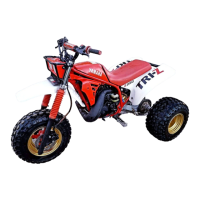RIDING YOUR
TRI-MOTO
Getting
to
Know
Your
Tri-Moto
Riding
your
Tri-Moto
requires
skills
ac-
quired
through
practice
over
a
period
of
time.
Take
the
time
to
learn
the
basic
techniques
well
before
attempting
more
difficult
maneuvers.
Riding your new Tri-Moto can
be
a very en-
joyable activity, providing your
with
hours
of
pleasure. But
it
is essential
to
familiarize
yourself
with
the operation
of
the Tri-Moto
to
acheive the skill necessary
to
enjoy riding safe-
ly. Before you begin
to
ride be sure you have
read
this Owner's Manual and Service com-
pletely and understand the operation
of
the
controls.
Pay
particular attention
to
the safety
information on page
1-6
-
1-8.
Please
also
read
all caution and warning labels on your
Tri-Moto.
Remember: your Tri-Moto
is
designed for one
person operation only. Do not carry passe-
ngers.
Learning
to
Ride
Your
Tri-Moto
Before
you
ride
always
perform
the
Preoperation
Checks
on
page
1-15.
The
short
time
spent
checking
the
condition
of
the
machine
will
be
rewarded
with
add-
ed
safety
and
a
more
reliable
Tri-Moto.
Always wear a helmet and goggles or other
eye
protection when you ride. You should also
wear gloves, boots, long pants and other pro-
tective clothing while riding your Tri-Moto.
Keep your hands on the handlebers and your
feet on the footrests
for
safety and control.
WARNING:
Be
sure
to
keep
your
feet
on
the
footrests
at
all
times
while
riding.
Otherwise,
your
feet
may
come
in
contact
with
the
rear
wheels
and
may
possibly
suffer
injury.
1-9
Select a large, flat
area
off-road
to
become
familiar with your Tri-Moto. Make sure that this
area
is
free
of
obstacles and other riders. You
should practice control
of
the throttle, brakes,
shifting procedures, and turning techniques
in
this
area
before trying more difficult terrai
n.
Avoid riding on paved surfaces: the Tri-
Moto
is
designed
for
off-road use only, and handl-
ing maneuvers
are
more difficult
to
perform on
pavement.
Always
put
the machine into neutral gear
to
start the engine. Once
it
has warmed up you
are
ready
to
begin riding your Tri-Moto. As you
get on the Tri-Moto,
be
sure not
to
acciden-
tally move the change pedal. Remember that
the engine and exhaust pipe will
be
hot when
riding and afterwards; do not allow skin or
clothing
to
come
in
contact
with
these
components.
Apply clutch lever, shift down the change pedal
to
the 1 st gear position and then release the
. clutch lever. Apply the throttle slowly and
smoothly. Once the Tri-Moto
has
attained ade-
quate speed, release the throttle and apply
clutch lever,
lift
the change pedal
to
the 2nd
gear position.
Release
the clutch lever and app-
ly the throttle smoothly.
Use
this same pro-
cedure
as
you move into the higher gears.
Be
sure
to
coordinate the
use
of
the throttle, clutch
lever, and change pedal properly.
Avoid
higher
speeds
until
you
are
thoroughly
familiar
with
the
operation
of
your
Tri-Moto.
Do
not
shift
gears
without
applying
clutch
lever.
Damage
to
the
engine
or
drive
train
may
occur.
WARNING:
Avoid
lifting
the
front
wheel
off
the
ground
or
making
the
machine
"wheelie."
Loss
of
directional
control,
overturning,
or
an
accident
may
occur.

